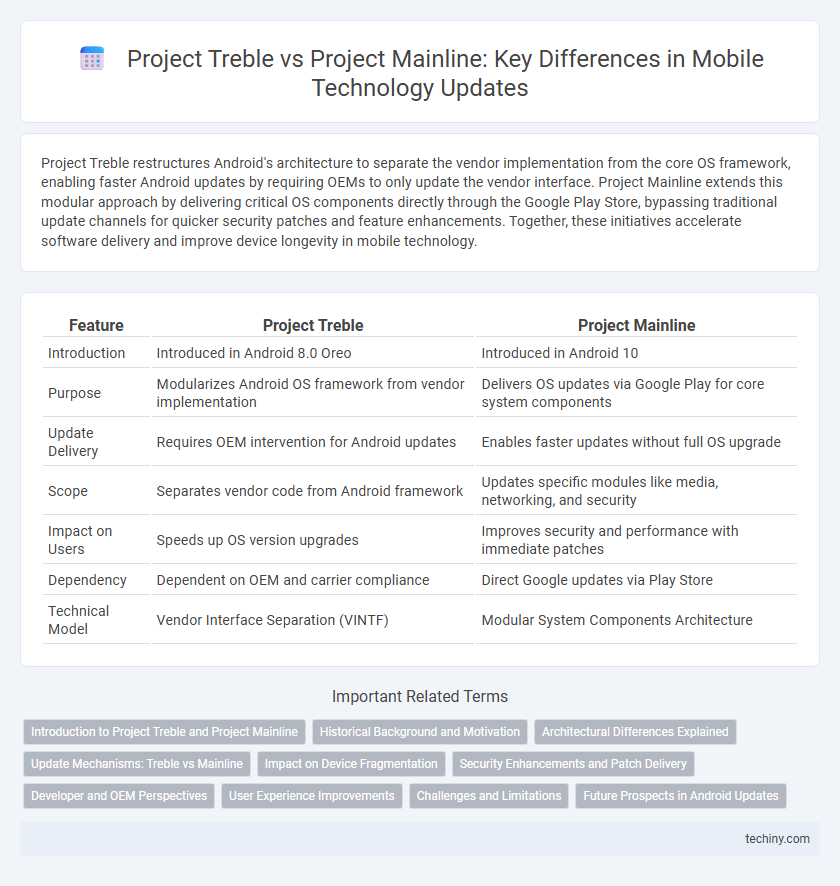Project Treble restructures Android's architecture to separate the vendor implementation from the core OS framework, enabling faster Android updates by requiring OEMs to only update the vendor interface. Project Mainline extends this modular approach by delivering critical OS components directly through the Google Play Store, bypassing traditional update channels for quicker security patches and feature enhancements. Together, these initiatives accelerate software delivery and improve device longevity in mobile technology.
Table of Comparison
| Feature | Project Treble | Project Mainline |
|---|---|---|
| Introduction | Introduced in Android 8.0 Oreo | Introduced in Android 10 |
| Purpose | Modularizes Android OS framework from vendor implementation | Delivers OS updates via Google Play for core system components |
| Update Delivery | Requires OEM intervention for Android updates | Enables faster updates without full OS upgrade |
| Scope | Separates vendor code from Android framework | Updates specific modules like media, networking, and security |
| Impact on Users | Speeds up OS version upgrades | Improves security and performance with immediate patches |
| Dependency | Dependent on OEM and carrier compliance | Direct Google updates via Play Store |
| Technical Model | Vendor Interface Separation (VINTF) | Modular System Components Architecture |
Introduction to Project Treble and Project Mainline
Project Treble restructured the Android OS framework by modularizing the vendor implementation, enabling faster and more efficient OS updates without waiting for full device manufacturer support. Project Mainline extends this modular approach by delivering critical OS components and security patches directly through Google Play, bypassing traditional update channels for streamlined maintenance. Both initiatives aim to enhance the Android update ecosystem, improving security and performance across a wide range of devices.
Historical Background and Motivation
Project Treble, introduced by Google in 2017 with Android Oreo, aimed to modularize the Android OS to accelerate vendor updates by separating the hardware-specific code from the Android framework. In contrast, Project Mainline, launched with Android 10 in 2019, focuses on delivering critical OS components and updates directly through Google Play, bypassing traditional OEM and carrier delays. Both initiatives address fragmentation and timely security patches, but Project Treble targets the hardware abstraction layer, while Project Mainline centers on modular system components.
Architectural Differences Explained
Project Treble restructures the Android OS framework by separating the vendor implementation from the Android OS framework via a stable vendor interface, enabling faster updates without waiting for hardware manufacturers. Project Mainline further modularizes the OS by delivering critical components as updatable modules directly through the Google Play system, bypassing traditional OEM and carrier update channels. This architectural shift in Mainline enhances security and update frequency by decoupling core system components from the full OS update process.
Update Mechanisms: Treble vs Mainline
Project Treble separates the Android OS framework from vendor implementations, enabling faster OS version updates by allowing manufacturers to update the Android framework independently from low-level hardware drivers. Project Mainline delivers security patches and critical system components directly through Google Play, bypassing the need for full device firmware updates and accelerating vulnerability fixes. Together, these update mechanisms enhance Android's modularity and provide more frequent, streamlined updates across a diverse range of devices.
Impact on Device Fragmentation
Project Treble modularizes Android's system architecture, enabling faster updates by separating vendor-specific code from the core OS, which reduces device fragmentation. Project Mainline extends this modularity by delivering critical OS components via Google Play, streamlining security and feature updates across devices regardless of manufacturer timelines. Combined, these initiatives significantly mitigate fragmentation by accelerating Android update adoption and improving consistency across diverse hardware.
Security Enhancements and Patch Delivery
Project Treble modularizes the Android OS framework, enabling faster integration of security patches by separating vendor implementation from the OS framework, which accelerates device updates. Project Mainline delivers security enhancements directly through the Google Play Store by updating critical system components independently of full OS upgrades, ensuring quicker and more consistent patch delivery. Together, these initiatives significantly improve Android's security posture by reducing the time and complexity involved in distributing vital security updates.
Developer and OEM Perspectives
Project Treble modularizes the Android OS framework, enabling faster system updates by separating vendor-specific hardware code from the core OS, which simplifies development and reduces fragmentation for OEMs. Project Mainline extends this modular approach by delivering critical OS components directly through Google Play System Updates, allowing developers and OEMs to push security patches and feature improvements independently of full OS releases. Together, these projects enhance developer efficiency and OEM flexibility by streamlining update deployment and improving device security across the Android ecosystem.
User Experience Improvements
Project Treble accelerates Android OS updates by modularizing the vendor implementation, enabling faster delivery of new features and security patches to users. Project Mainline enhances user experience through direct updates of essential system components via Google Play, reducing dependency on full OS upgrades. Together, these initiatives streamline update processes, improving device performance, security, and user satisfaction.
Challenges and Limitations
Project Treble and Project Mainline aim to improve Android update efficiency but face distinct challenges and limitations. Project Treble's modular architecture reduces vendor implementation delays but struggles with fragmented hardware compatibility and slower adoption by OEMs. Project Mainline enhances security and feature delivery via Google Play updates but is limited by the scope of modules it can update and still depends on OEM support for full system improvements.
Future Prospects in Android Updates
Project Treble modularizes the Android OS framework, enabling faster Android version updates by separating vendor-specific code from the core system, significantly reducing the dependency on manufacturers and carriers. Project Mainline extends this approach by delivering essential OS components directly through Google Play, allowing for more frequent security patches and feature improvements without requiring a full system upgrade. Future prospects for Android updates indicate a synergistic use of both projects to enhance update speed, security, and device longevity across diverse hardware ecosystems.
Project Treble vs Project Mainline Infographic

 techiny.com
techiny.com